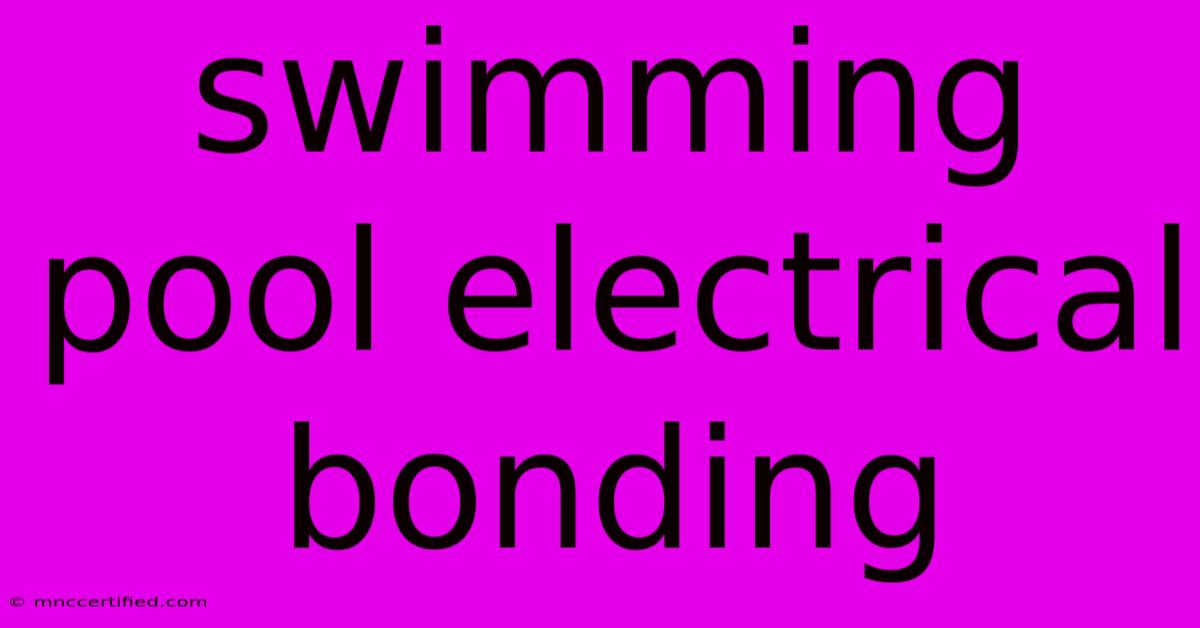Swimming Pool Electrical Bonding

Table of Contents
Swimming Pool Electrical Bonding: A Comprehensive Guide to Safety and Compliance
Swimming pools present a unique set of electrical hazards. Water is an excellent conductor, and the presence of metal components like ladders, handrails, and underwater lights increases the risk of electric shock. This is where swimming pool electrical bonding comes in. It's a crucial safety measure that significantly reduces the risk of electrocution. This comprehensive guide will explain what it is, why it's necessary, and how to ensure your pool is correctly bonded.
What is Swimming Pool Electrical Bonding?
Electrical bonding in a swimming pool context involves connecting all metallic parts within and around the pool to create a single, equipotential plane. This means that all the metal components are at the same electrical potential. If a fault occurs, for example, a live wire touching the pool's metal ladder, the bonding ensures that the voltage is equally distributed, minimizing the risk of a dangerous shock. Instead of a potentially lethal voltage difference between the ladder and the surrounding ground, the voltage is effectively neutralized.
Key Components Included in Bonding:
- Pool Shell: If the pool shell is metallic (e.g., steel or aluminum), it must be bonded.
- Pool Equipment: This includes pumps, filters, heaters, and other metallic components.
- Metallic Fixtures: This includes ladders, handrails, underwater lights, and any other metal parts within or surrounding the pool.
- Surrounding Structures: Metal fences, gates, and other metallic structures within a certain radius of the pool should also be considered for bonding.
- Grounding Electrode: A dedicated grounding electrode, typically a ground rod, is essential for effective bonding. This provides a path to earth for fault currents.
Why is Swimming Pool Electrical Bonding Necessary?
Safety is paramount. Without proper bonding, a fault in the electrical system could result in a potentially fatal electric shock. A person touching a faulty metallic component in the pool could experience a significant voltage difference, leading to severe injury or death. Bonding significantly reduces this risk by ensuring that all metal parts are at the same potential, minimizing voltage differences.
Compliance with Electrical Codes: Electrical bonding for swimming pools is mandated by building codes and electrical safety regulations in most jurisdictions. Failure to comply could result in hefty fines and legal liabilities.
Protecting Your Investment: Proper bonding protects your pool equipment from damage caused by electrical faults. By providing a low-resistance path for fault currents, bonding helps prevent damage to expensive pumps, heaters, and other components.
How is Swimming Pool Electrical Bonding Achieved?
Bonding is typically achieved using copper bonding wires of a specified gauge, connected to the various metallic components using appropriately sized clamps and connectors. These connections must be made securely and correctly to ensure a reliable and effective bond. The copper bonding wires are then connected to the grounding electrode.
The Importance of Proper Installation:
Professional Installation: It's crucial to hire a qualified and experienced electrician for swimming pool electrical bonding. Improper installation can render the bonding ineffective, leaving you vulnerable to electrical hazards.
Regular Inspection: Regular inspection of the bonding system is vital to ensure that all connections remain secure and corrosion hasn't compromised the bond.
Use of Correct Materials: Using the correct size and type of bonding wire and connectors is crucial for a safe and effective bond.
Beyond Bonding: Additional Safety Measures
While electrical bonding is crucial, it's only one part of a comprehensive swimming pool safety plan. Other essential measures include:
- Ground Fault Circuit Interrupters (GFCIs): GFCIs are essential safety devices that detect ground faults and quickly shut off the power, preventing electric shocks. They should be installed on all electrical outlets and circuits associated with the pool area.
- Proper Wiring: Ensure all electrical wiring is properly installed and protected from moisture and damage.
- Regular Maintenance: Regular maintenance of the pool's electrical system is vital for safety and longevity.
Conclusion: Prioritizing Safety with Swimming Pool Electrical Bonding
Swimming pool electrical bonding is not just a recommendation; it's a critical safety requirement. It minimizes the risk of electrocution, protects your equipment, and ensures compliance with regulations. By understanding the importance of proper bonding and ensuring professional installation and regular inspection, you can create a safe and enjoyable swimming environment for everyone. Don't compromise on safety; invest in proper electrical bonding for your pool.
Keywords: swimming pool electrical bonding, pool bonding, electrical safety, swimming pool safety, ground fault circuit interrupter, GFCI, electrical code, pool equipment, bonding wire, copper bonding wire, electrical installation, pool maintenance, electrocution prevention, safety regulations
Off-page SEO strategies: Building backlinks from relevant websites (e.g., pool supply companies, electrician websites, home improvement blogs) will help improve this article's search engine ranking. Promoting the article on social media and engaging with relevant online communities will also be beneficial.

Thank you for visiting our website wich cover about Swimming Pool Electrical Bonding. We hope the information provided has been useful to you. Feel free to contact us if you have any questions or need further assistance. See you next time and dont miss to bookmark.
Featured Posts
-
Bond No 9 Bleecker Street Review
Nov 21, 2024
-
Crypto Aero Wholefood Horse Feed
Nov 21, 2024
-
Insurance Companies Champaign Il
Nov 21, 2024
-
Fortnite Update Timing Juice Wrld
Nov 21, 2024
-
Davis Dental Insurance Providers
Nov 21, 2024